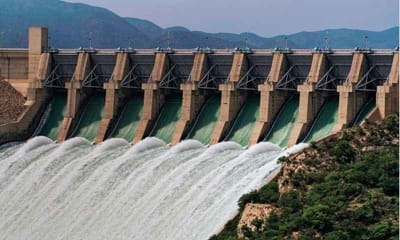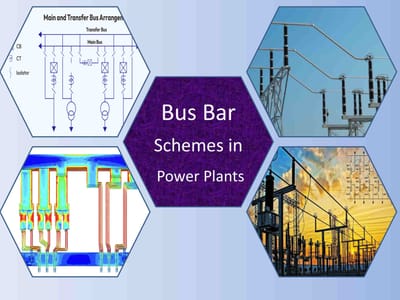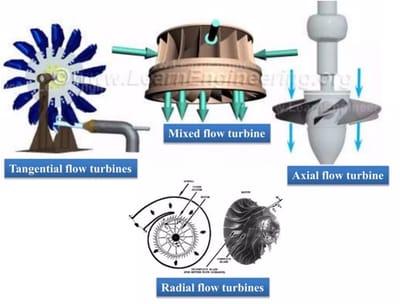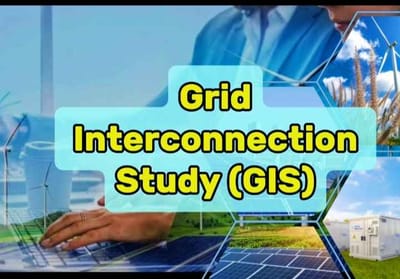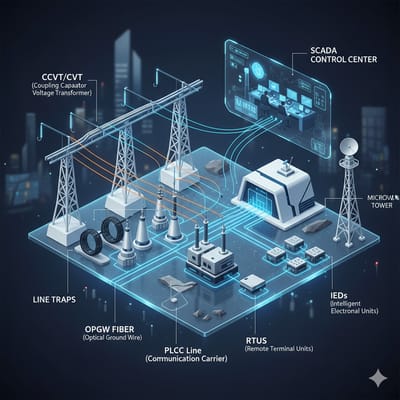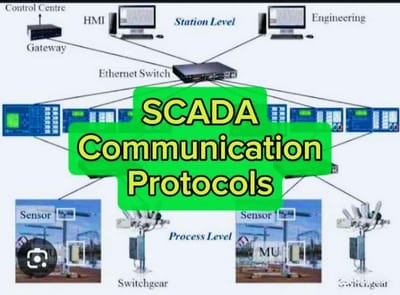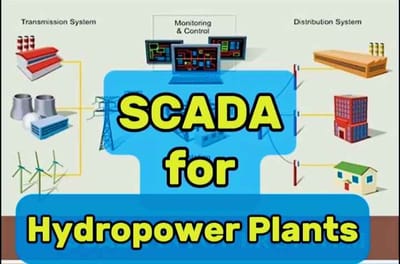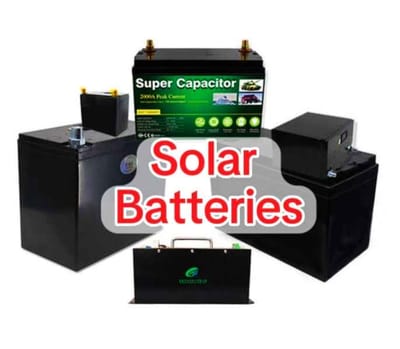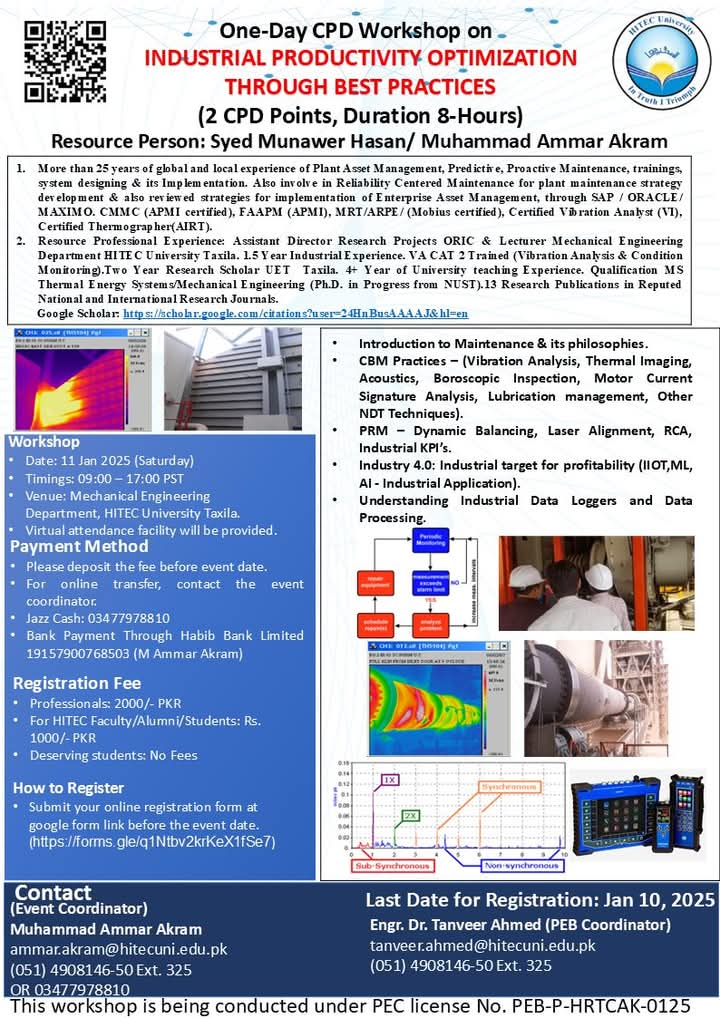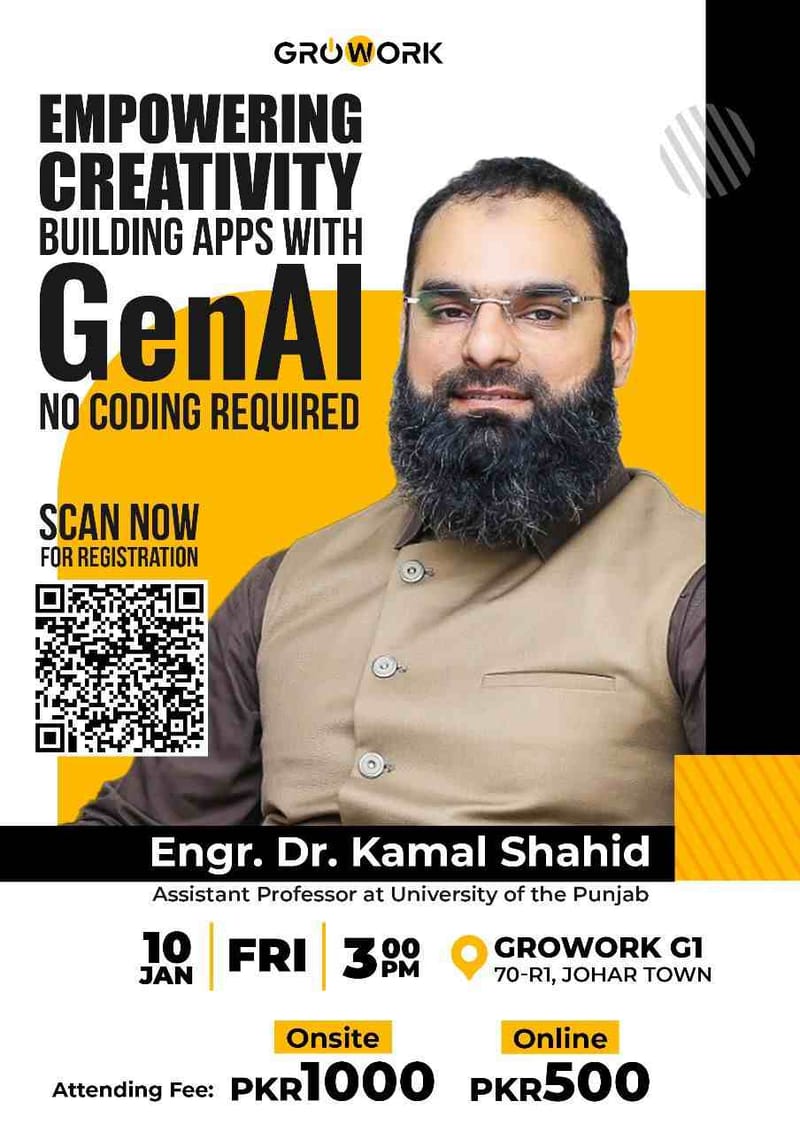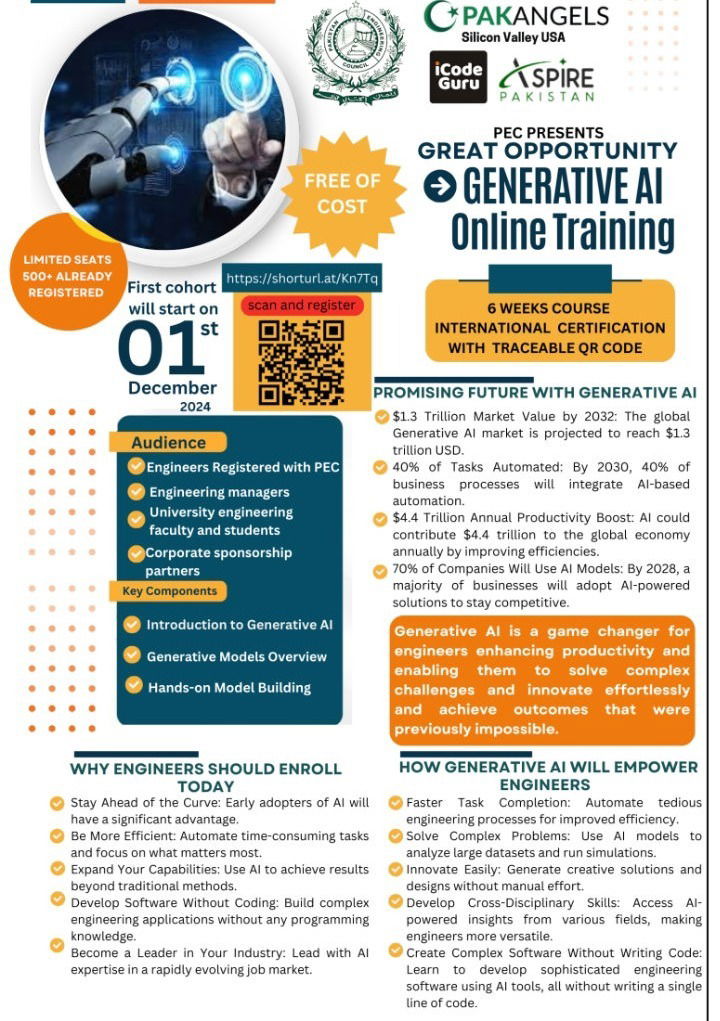LuminCore Technologies
Transforming energy challenges into opportunities
Electrical Engineering Articles
When we consider the complexity of renewable energy projects, hydropower is the most complicated among others, especially we construct it on a river that cross the national borders. Now we look at major controversies in hydropower project in past few years, and what lessons we have to learn for future development. Hydropower Plants are a good way to meet the world's growing demand for clean and green energy. These plants use natural features of the land and provide power closer to where it's needed, unlike other sources like far-off wind farms or solar panels in deserts.
Read MoreSwitchyards are critical components of electric power plants, acting as the central hub for transmitting and distributing electrical power. At the heart of every switchyard lies the bus-bar system, which plays a vital role in ensuring efficient and reliable power transfer. Bus-bar schemes are designed to accommodate various operational requirements, fault tolerance, and flexibility. In this article, we will explore the different types of bus-bar schemes used in switchyards and how they work. 1. Single Bus-Bar Scheme 2. Double Bus-Bar Scheme 3. Main and Transfer Bus 4. Ring Bus Scheme 5. Breaker and Half Scheme
Read MoreHydro turbines are essential components in the generation of hydroelectric power, converting the energy of flowing or falling water into mechanical energy, which is then transformed into electrical energy. In this article, we will explore the fundamentals of hydro turbines, their classification, design parameters, and the advantages and disadvantages of using them for power generation.
Read MoreHydropower Plants are essential for generation of renewable energy by harnessing the energy of moving water. One of the most important component of Hydropower Plant is the turbine. The turbine converts the energy of moving / flowing water into mechanical energy, later which is converted into electrical energy by generator. The choice of turbine depends on multiple factors, such as net head, flow rate of water and geological conditions of the site. In this article we will explore different types of turbines commonly used in Hydropower Plants, specification of each turbine, output power range and geological conditions.
Read MoreGrid Interconnection Study (GIS) is a crucial analysis in the energy sector that involves assessing the technical, economic, and regulatory aspects of connecting a power generation source (such as solar, wind, hydro, or fossil fuel-based plants) to the existing electrical grid. As energy systems around the world evolve to incorporate renewable energy sources and meet growing demands, understanding the optimal way to integrate these energy sources into the grid becomes essential. GIS helps ensure that the electrical grid can handle additional generation while maintaining stability, reliability, and efficiency.
Read MoreModern power systems rely heavily on fast, reliable, and secure communication. As the voltage level increases—particularly at 220 kV and above—the need for seamless communication becomes even more critical. High-voltage grid stations must coordinate protection systems, exchange real-time data, and ensure operational safety across long distances. To achieve this, utilities use a range of specialized communication components. In this article, we’ll explore the major communication systems used in 220 kV and higher-level substations, along with a clear explanation of the role each component plays.
Read MoreBy using a PLC, all control tasks can be integrated for automatic operation. This makes unit control and data recording much simpler. Supervisory control and data acquisition can also be achieved through PLC and a supervisory computer. Some of the main roles of the PLC in automating a hydropower plant include: (a) Automatic Start Sequence (b) Automatic Shutdown (Normal, Emergency) (c) Digital Governing using PLC (d) Speed Governing (e) Position Control (f) Excitation Control with PLC (g) Protection System with PLC (h) Alarm and Annunciation using PLC
Read MoreCommunication protocols are needed to connect different control and protection systems to SCADA in Hydropower Plants. These protocols, either standard or custom, work over serial connections to send information between the control center and remote locations. They use different methods like phone lines, cables, fiber optics, and radio signals such as broadcast, microwave, and satellites. The most commonly used communication protocols are listed below.
Read MoreIntroduction: Supervision means overseeing a process and making sure it works well. To do this, a supervisory system collects, monitors, and records important data about the process to detect any issues and alert the operator. The main goal of a supervisory system is to help the operator control and manage an automated process. Supervising industrial processes involves tasks that ensure the process is controlled and works properly.
Read MoreSolar panels have been a game-changer in the world of renewable energy. They help us harness the power of the sun to generate electricity, reducing our reliance on fossil fuels. But what happens when the sun goes down? For years, this has been a limitation of solar technology—until now. Scientists have recently invented the world’s first dark solar panel, a breakthrough that can generate energy even in moonlight!
Read MoreChoosing the right power cable is an essential part of electrical engineering. It helps ensure the safe, efficient, and reliable operation of electrical systems by preventing issues like voltage drops, overheating, and energy loss. In this post, we’ll go over two easy methods for selecting cable sizes, with a focus on practical use in 3-phase systems.
Read MoreAs the world increasingly turns to renewable energy sources like solar power, one of the biggest challenges is storing the energy generated for later use. This is where solar batteries come in. Among the various types, two cutting-edge technologies, supercapacitor batteries and graphene batteries, are gaining attention for their potential to revolutionize solar energy storage.
Read MoreElectrical Engineering Interview Question and Answers
What is the SCADA System?
What's mean by PLC?
Why SCADA Systems are implemented in industries?
What is HMI in SCADA System?
What are the Main Components of SCADA System?
What is Encoder and its working?
What are the advantages of speed Control using Thyristor?
On which principle Electric motor works?
Why, When birds sit on uninsulated conductor does not get electric shock?
What is mean by armature reaction in motors?
What happen if we supply 220 Volt DC to Bulb or Tube Light?
1. Incandescent Bulb: It may work briefly, but the filament can burn out quickly because DC causes the filament to heat continuously in one direction, leading to faster wear and failure.
2. LED Bulb: Many LED bulbs have internal circuits that convert AC to DC. Supplying 220V DC could overload these circuits, damaging the bulb.
3. Fluorescent Tube Light: These lights use a ballast and starter designed for AC, so supplying DC may prevent the tube from lighting or cause it to fail.
What is ACSR Cable and where it used?
What will happen if Power Factor is leading in distribution of power?
- Voltage rise, which can damage equipment.
- Reduced system efficiency, leading to possible instability.
- Overload on generators and transformers, affecting their performance.
What is the main difference between UPS and Inverter?
- UPS provides instant backup power during an outage, ensuring no interruption to connected devices like computers. It also regulates voltage to protect against fluctuations.
- Inverter converts DC power (from batteries or solar) to AC power for use, but there is usually a delay when switching from grid power to battery power.
What is Two Phase motor?
What is the significance of Vector Grouping in Power Transformer?
Which type of Motors are used in the Fans (Ceiling Fan, Padestal Fan, Bracket Fan etc) in houses?
Give two basic speed control scheme of DC Shunt Motors?
- Armature Voltage Control: The speed is controlled by varying the voltage applied to the armature. Increasing the armature voltage increases the speed, while decreasing it reduces the speed.
- Field Flux Control: The speed is controlled by varying the field current, which changes the magnetic flux. Reducing the field current increases the speed, while increasing it reduces the speed.
1 Ton is equal to how many watts?
- Conversion from BTU/hr to Watts:
1 Ton of refrigeration =12,000 BTU/hr1 We know that:
1 BTU/hr=0.293071 watts - Calculating the value in watts:
12,000 BTU/hr×0.293071 watts/BTU/hr=3,517 watts
Why Capacitor Work on A.C Supply only?
Why we use VCB in High Transmission Voltage instead ACB?
What is the Difference between Surge Arrestor and Lighting Arrestor?
Explain the Working Principle of Circuit Breaker?
What happens if I connect a capacitor to a generator load?
What is Power Factor? Whether it should be High or Low and Why?
Power factor values range from 0 to 1, where 1 (or 100%) indicates perfect efficiency.
- Higher Efficiency: A high power factor means that more of the power supplied is being effectively used for work, reducing losses in the system.
- Reduced Generator Load: A higher power factor reduces the current drawn, which in turn lowers the load on the generator, making it more efficient and cost-effective.
- Lower Energy Costs: Many utility companies charge extra for low power factor because it requires more power to deliver the same amount of useful work.
Why Synchronous Generator are used for production of Electricity?
What is Stepper Motor, list its applications?
- 3D Printers: Used for precise movement of the print head and bed.
- CNC Machines: Control the movement of machine tools in manufacturing processes.
- Robotics: Enable accurate movements of robotic arms and components.
- Disk Drives: Control the positioning of read/write heads in hard disk drives.
- Camera Auto-Focus: Drive the lens to focus the camera precisely.
- Time Clocks and Watches: Used in electronic time-keeping devices for accurate time movement.
- X-Y Plotters: Control the movement of pens or tools in two-dimensional plotting.
- Automatic Door Systems: Control the opening and closing mechanisms.
- Textile Industry: Used in automatic looms for fabric production.
What is the difference between Isolator and Circuit Breaker?
- Function:
- Isolator: Isolates a part of the circuit for maintenance, and operates when no current is flowing.
- Circuit Breaker: Automatically disconnects the circuit during faults like overloads or short circuits.
- Operation:
- Isolator: Manually operated, only when the circuit is de-energized.
- Circuit Breaker: Automatically operated, can break the circuit under normal or fault conditions.
- Current Flow:
- Isolator: Used when there is no current flow.
- Circuit Breaker: Used to break the current flow during faults.
What is SF6 Circuit Breaker?
It is reliable and commonly used in power transmission and substations to protect electrical circuits. However, SF6 is a greenhouse gas, and there are ongoing efforts to find alternatives.
What is Ferranti Effect?
Why we do two types of Earthing in Transformers? and its function
- Body earthing connects the transformer's metallic body to the ground, protecting people from electric shock in case of insulation failure or a fault, by providing a low-resistance path for leakage currents.
- Neutral earthing connects the neutral point of the transformer to the ground, stabilizing the system voltage. It helps in fault detection and clearing, allowing the current from faults (like a short circuit) to flow safely to the ground and preventing equipment damage.
Why Delta-Star Transformers are used in Lighting Load?
- Stable Voltage: The star connection on the secondary side provides a neutral point, which ensures a stable voltage (typically 230V or 415V) for lighting circuits.
- Balanced Load Distribution: The delta connection on the primary side helps to balance the load and reduce the risk of voltage fluctuations, providing smooth operation for lighting loads.
- Reduced Harmonics: The delta connection reduces third harmonic currents, improving power quality and ensuring that lighting circuits operate efficiently without flicker or instability.
- Safety: The star connection provides a neutral point for grounding, enhancing safety for the lighting load and protecting against electrical faults.
In three pin plugs, Why Earth pin is thicker and longer than other pins?
What is the Value of Power Factor of an alternator at no load?
What will happen if we supply DC Voltage on Primary Side of Transformer?
- No Secondary Voltage: A constant magnetic field is created, so no voltage is induced in the secondary winding after the initial application.
- Core Saturation: The transformer core saturates because DC does not produce a changing magnetic flux, leading to inefficient operation.
- Overheating: The transformer will draw excessive current, causing overheating and potential damage to the windings and insulation.
- Protection Tripping: The high inrush current may trip fuses or circuit breakers.
What is the transformer efficiency and what are the conditions for Maximum efficiency?
What are the Four main uses of a Transformer?
How many are the types of transformers?
There are several types of transformers, but the main ones are:
- Step-Up Transformer: Increases the voltage from primary to secondary winding, used for long-distance power transmission.
- Step-Down Transformer: Decreases the voltage from primary to secondary winding, commonly used in power distribution to homes and industries.
- Isolation Transformer: Provides electrical isolation between circuits to ensure safety, often used in sensitive equipment like medical devices.
- Autotransformer: Has a single winding that acts as both primary and secondary, used for voltage regulation or starting motors.
- Current Transformer (CT): Used for measuring and monitoring electrical current in high-voltage circuits.
- Potential Transformer (PT): Used for measuring high voltages and stepping them down to a lower level for measurement and monitoring.
- Toroidal Transformer: Has a donut-shaped core and is used in applications requiring compact and efficient transformers, like in audio systems and power supplies.
How many are the types of transformers? On the Basis of Load
Based on load, transformers can be classified into the following types:
- Core-Type Transformer:
- The windings are placed around the core, and the core is made of laminated steel.
- It is suitable for high-load applications and typically used in power transmission and distribution.
- Shell-Type Transformer:
- The windings are placed inside the core, and the core surrounds the windings.
- It is designed to handle larger loads with better efficiency and is often used in industrial applications.
- Distribution Transformer:
- These transformers are used to step down voltage in residential or commercial areas and operate under medium to light loads.
- They are commonly seen in power distribution networks.
- Power Transformer:
- These are large transformers designed to handle heavy loads, often found in power plants and substations to step up or step down high voltage.
- Load Tap Changer (LTC) Transformer:
- These transformers are equipped with a mechanism to adjust the voltage ratio under different load conditions, maintaining optimal performance across varying load levels.
Services
Smart Grids Implementation
We provide smart grid solutions that integrate advanced communication technologies for intelligent energy management.
Renewable Energy Solutions
Our renewable energy services include solar, wind, and hybrid systems for sustainable energy management.
Power Systems Engineering
We design and optimize power systems to enhance efficiency and reliability in energy distribution.
Jobs in Pakistan
Electronics / Embedded / Mechanical Engineer at ESOLS Engineering
ESOLS (Engineering Education Equipment) Multan, Pakistan, a leading Engineering Education Equipment Manufacturing & exporting Company of the country, invites applications from experienced energetic individuals to undergo permanent job in the following disciplines.
1. Positions: Electronics / Embedded Engineer
- No. of Seats: 02
- Qualification Required: B.E/B.Sc Engineering in Electronics/Mechatronics having knowledge in 1. National Instruments LabView development 2. Embedded software development using C 3. Windows desktop software development, ideally C# 4. Arduino, Nextion LCD, Raspberry Pi, PLC etc.
- Last Date: 22-10-2025
- Email: esolsengineering@gmail.com
- Address: ESOLS Factory: 1.3km Southern Bypass Dunyapur Road Multan. Pakistan
- No. of Seats: 02
- Qualification Required: B.E/B.Sc Engineering in Mechanical/Manufacturing having knowledge in 1. 3D Modeling (preferably in Solidworks and Autocad). 2. Should know how to read 2D drawings 3. Good basic concepts in Mechanical Engineering 4. Should have good communication skills.
- Last Date: 22-10-2025
- Email: esolsengineering@gmail.com
- Address: ESOLS Factory: 1.3km Southern Bypass Dunyapur Road Multan. Pakistan
Position AGM Projects / Project Manager / Manager Construction / Project Coordinator in AZHAR Group
Career Opportunities
1. Position: AGM Projects
- Qualification & Experience Required: 1. BSc in Civil Engineering; Master’s preferred. 2. Capable of handling multiple projects. 3. 20+ years’ experience in managing large-scale construction projects.
- Location: Lahore
- Last Date: 31-08-2025
- Email: jobs@izhar.com
- Qualification & Experience Required: 1. BSc in Civil Engineering; Master’s preferred. 2. 12+ years’ experience managing medium to large-scale construction projects.
- Location: As required.
- Last Date: 31-08-2025
- Email: jobs@izhar.com
- Qualification & Experience Required: 1. 15+ years’ experience of managing on-site construction activities. 2. Proven ability to deliver projects on time, within budget, and to required quality standards.
- Location: As required.
- Last Date: 31-08-2025
- Email: jobs@izhar.com
- Qualification & Experience Required: 1. BSc in Civil Engineering; Master’s preferred. 2. Min 7 years’ experience in project coordination, reporting, and site monitoring.
- Location: Lahore
- Last Date: 31-08-2025
- Email: jobs@izhar.com
Graduate Trainee Program 2025
We are a well-established and reputable organization in the renewable energy sector, control & protection and energy generation, currently inviting applications for our Trainee Engineer Program – 2025. Intake from highly motivated and competent fresh graduates in the fields of
1. Electrical Engineering
2. Mechanical Engineering
3. Electronics / Instrumentation Engineering
4. Chemical Engineering.
For Apply Online Click Here
Applicants must have graduated from a recognized engineering university no later than 2024, with a minimum CGPA of 3.0.Selected candidates will undergo a structured, on-site technical training program and will be deployed across various project locations in Pakistan.
Deadline to Apply: 30th July, 2025
For Apply Online Click Here
Job Opportunities at SNGPL - Engineer (Grade II - III), Officer (Grade II-III), Officer HR (Grade II - III), Officer Law (Grade II - III), Executive Accountant/Officer (Grade IV), Information Security Officer (Grade II - III)
Job Opportunities
SNGPL is a leading gas utility company in Pakistan engaged in the business of transmission and distribution of natural gas in Punjab, Khyber Pakhtunkhwa, Azad Kashmir, and the Federal Capital. We are looking for qualified professionals who can contribute to the company’s success in changing business dynamics while entering into new business ventures. We have the following job opportunities at present:
1. Position: Engineer (Grade II - III)
- Qualification Required: M.Sc. (Engineering) OR B.Sc. (Engineering) in Chemical, Mechanical, Civil, Electrical/Electronics, Telecom/Communication, Petroleum & Gas, Metallurgy & Materials, Mechatronics.
- Experience: 0-1 Year
- Age Limit: Max (Grade-III = 35, Grade-II = 32)
- Last Date: 04-08-2025
- For Apply Online Click Here
- Qualification Required: 18 years schooling OR 16 years schooling with HEC accredited/recognized degree in Management, Business Administration, Public Administration, Marketing, Logistics/Supply Chain Management, Economics, Mathematics, Statistics.
- Experience: 0–2 Years (Grade-III), 1–3 Years (Grade-II)
- Age Limit: Max (Grade-III = 35, Grade-II = 32) Years
- Last Date: 04-08-2025
- For Apply Online Click Here
- Qualification Required: M.Phil/MS/MBA with specialization in HR (18 years schooling) OR MBA(HR)/Masters in HRM/BBA-HR (4 years) (16 years schooling)
- Experience: 0–2 Years (18 years schooling), 1–3 Years (16 years schooling)
- Age Limit: Max (Grade-III = 35, Grade-II = 32) Years
- Last Date: 04-08-2025
- For Apply Online Click Here
- Qualification Required: Law Graduate with 18 years schooling OR 16 years schooling.
- Experience: 0–2 Years (18 years schooling), 1–3 Years (16 years schooling)
- Age Limit: Max (Grade-III = 35, Grade-II = 32) Years
- Last Date: 04-08-2025
- For Apply Online Click Here
- Qualification Required: CA / CMA
- Experience: Nil
- Age Limit: Max 38 Years
- Last Date: 04-08-2025
- For Apply Online Click Here
- Qualification Required: M.Sc.(CS)/MBA (IT)/BBA(IT)/BCS (4 years)/B.Sc. (Engineering - IT)
- Experience: 1 - 3 Years
- Age Limit: Max (Grade-III = 35, Grade-II = 32) Years
- Last Date: 04-08-2025
- For Apply Online Click Here
- Qualification Required: M.Sc.(CS)/MBA (IT)/BBA(IT)/BCS (4 years)/B.Sc. (Engineering - IT)
- Experience: 1 - 3 Years
- Age Limit: Max (Grade-III = 35, Grade-II = 32) Years
- Last Date: 04-08-2025
- For Apply Online Click Here
- Qualification Required: M.Sc.(CS)/MBA (IT)/BBA(IT)/BCS (4 years)/B.Sc. (Engineering - IT)
- Experience: 1 - 3 Years
- Age Limit: Max (Grade-III = 35, Grade-II = 32) Years
- Last Date: 04-08-2025
- For Apply Online Click Here
Assistant Manager (Mechanical) / Assistant Manager (Mechatronics) / Assistant Manager (Electronics) / Assistant Manager (Metallurgy) / Assistant Manager (Chemical) / Assistant Manager (IT) / Assistant Manager (HR / Admin) Jobs in Public Sector Organization
A Public Sector Organization (2381) is looking for highly energetic and dedicated professionals who are interested to work in a challenging environment for the following positions on Contract basis against a specific project.
1. Assistant Manager (Mechanical)
- Qualification Required: B.E / B.Sc in relevant field with 1st Division
- Experience Required: Relevant experience will be preferred.
- Last Date: 03-07-2025
- For Apply Online Click Here
- Qualification Required: B.E / B.Sc in relevant field with 1st Division
- Experience Required: Relevant experience will be preferred.
- Last Date: 03-07-2025
- For Apply Online Click Here
- Qualification Required: B.E / B.Sc in relevant field with 1st Division
- Experience Required: Relevant experience will be preferred.
- Last Date: 03-07-2025
- For Apply Online Click Here
- Qualification Required: B.E / B.Sc in relevant field with 1st Division
- Experience Required: Relevant experience will be preferred.
- Last Date: 03-07-2025
- For Apply Online Click Here
- Qualification Required: B.E / B.Sc in relevant field with 1st Division
- Experience Required: Relevant experience will be preferred.
- Last Date: 03-07-2025
- For Apply Online Click Here
- Qualification Required: BCS / BS-IT in relevant field with 1st Division
- Experience Required: Relevant experience will be preferred.
- Last Date: 03-07-2025
- For Apply Online Click Here
- Qualification Required: M.Sc in relevant field with 1st Division
- Experience Required: Relevant experience will be preferred.
- Last Date: 03-07-2025
- For Apply Online Click Here
- Qualification Required: MBA/BBA (04 years)/MPA/MAS/MSc/MA HRM/MS or equivalent Post Graduation (04 years degree course after intermediate) in the relevant field with 1st Div.
- Experience Required: Relevant experience will be preferred.
- Last Date: 03-07-2025
- For Apply Online Click Here
Assistant Manager (Electronics) / Assistant Manager (Mechanical) / Assistant Manager (IT) / Assistant Manager (HR) / Assistant Manager (Admin) / Medical Officer Jobs in Public Sector Organization
A Progressive Public Sector Organization invites applications from Pakistani Nationals for the following posts for ISLAMABAD & KARACHI regions.
1. Name of Post: Assistant Manager (Electronics)
- Qualification Required: BE / BSc (Engg) (1st Div) in the relevant field OR MS / MSc (Engg) (1st Div) in the relevant field.
- Experience Required: Experience in relevant field will be preferred.
- Station for Interview: Islamabad / Karachi
- Last Date: 06-07-2025
- For Apply Online Click Here
- Qualification Required: BE / BSc (Engg) (1st Div) in the relevant field OR MS / MSc (Engg) (1st Div) in the relevant field.
- Experience Required: Experience in relevant field will be preferred.
- Station for Interview: Islamabad / Karachi
- Last Date: 06-07-2025
- For Apply Online Click Here
- Qualification Required: BE / B.Sc Computer Engineering / BCS / BS-IT / BSCS / MCS / MS-IT with 1st Division
- Experience Required: Experience in relevant field will be preferred.
- Station for Interview: Islamabad / Karachi
- Last Date: 06-07-2025
- For Apply Online Click Here
- Qualification Required: MBA / BBA (04 years) / MPA / MAS / MSc / MA HRM / MS or equivalent Post Graduation (04 Years degree course after intermediate) in the relevant field with 1st Div.
- Experience Required: Experience in relevant field will be preferred.
- Station for Interview: Karachi
- Last Date: 06-07-2025
- For Apply Online Click Here
- Qualification Required: MBA / BBA (04 years) / MPA / MAS / MSc / MA HRM / MS or equivalent Post Graduation (04 Years degree course after intermediate) in the relevant field with 1st Div.
- Experience Required: Experience in relevant field will be preferred.
- Station for Interview: Islamabad
- Last Date: 06-07-2025
- For Apply Online Click Here
- Qualification Required: MBBS (1st Div) (After successful completion of House Job)
- Experience Required: Experience in medical field will be preferred.
- Station for Interview: Karachi
- Last Date: 06-07-2025
- For Apply Online Click Here
Deputy Lead Manager / Manager Gas Purchase / Manager Projects / Manager Insurance / Manager Tender Evaluations Jobs Sui Southern Gas Company Limited
EMPLOYMENT OPPORTUNITIES
Sui Southern Gas Company Limited, a leading Public Sector Utility Company in Pakistan is looking to fill the following specialized positions with qualified, experienced and dynamic professionals who can add value to the organization’s progress.
1. Position: Deputy Lead Manager - Gas Purchase
- Qualification / Experience: CA / ACMA with at least 4 years of post-membership experience Or ACCA / MBA in Finance from HEC recognized university with at least 6 years of experience
- Last Date: 30-06-2025
- For Apply Online Click Here
- Qualification / Experience: CA / ACMA with at least 4 years of post-membership experience Or ACCA / MBA in Finance from HEC recognized university with at least 6 years of experience
- Last Date: 30-06-2025
- For Apply Online Click Here
- Qualification / Experience: Fresh CA / ACMA Or ACCA / MBA in Finance from HEC recognized university with at least 4 years of experience
- Last Date: 30-06-2025
- For Apply Online Click Here
- Qualification / Experience: Fresh CA / ACMA Or ACCA / MBA in Finance from HEC recognized university with at least 4 years of experience
- Last Date: 30-06-2025
- For Apply Online Click Here
- Qualification / Experience: Master’s degree in Finance, Insurance or Risk Management (18 years of education) from HSE recognized University with at least 4 years of experience. Insurance related professional qualification Dip CII, ARM or CPCU will be preferred.
- Last Date: 30-06-2025
- For Apply Online Click Here
- Qualification / Experience: Fresh CA / ACMA with strong knowledge of PPRA Or ACCA / MBA preferably in Finance from HEC recognized university with at least 4 years of experience.
- Last Date: 30-06-2025
- For Apply Online Click Here
- Qualification / Experience: CA / ACMA with at least 6 years of post-membership experience Or ACCA / MBA in Finance from HEC recognized university with at least 9 years of experience. Functional team lead experience of at least 4 years is mandatory
- Last Date: 30-06-2025
- For Apply Online Click Here
- Qualification / Experience: CA / ACMA with at least 4 years of post-membership experience Or ACCA / MBA in Finance from HEC recognized university with at least 6 years of experience.
- Last Date: 30-06-2025
- For Apply Online Click Here
- Qualification / Experience: Fresh CA / ACMA Or ACCA / MBA in Finance from HEC recognized university with at least 4 years of experience
- Last Date: 30-06-2025
- For Apply Online Click Here
- Qualification / Experience: Fresh CA / ACMA Or ACCA / MBA in Finance from HEC recognized university with at least 4 years of experience
- Last Date: 30-06-2025
- For Apply Online Click Here
Professor, Associate Professor, Assistant Professor and Lecturer Jobs GIKI
Join GIK - A Premier Engineering Institute
GIK Institute, a leading university, engaged in shaping the future of engineering, technology and innovation, offers job opportunities for well qualified and brightest minds to serve against the following Positions
1. Civil Engineering Department
- Associate Professor
- Assistant Professor
- Lecturer
Last Date: 16-06-2025
For Apply Online Click Here
2. Electrical Engineering Department
- Associate Professor
- Assistant Professor
- Lecturer
Last Date: 16-06-2025
For Apply Online Click Here
3. Mechanical Engineering Department
- Associate Professor
- Assistant Professor
- Lecturer
Last Date: 16-06-2025
For Apply Online Click Here
4. Faculty of Basic Sciences
- Associate Professor
- Assistant Professor
- Lecturer
Last Date: 16-06-2025
For Apply Online Click Here
5. School of Management Sciences
- Associate Professor
- Assistant Professor
- Lecturer
Last Date: 16-06-2025
For Apply Online Click Here
Team Lead(Accounts / Design & Standard / Risk Management) / Specialist (Policy / Legal / Distribution Planning / Transmission Planning / Human Resources / Data Analyst / Data Monitoring) Jobs PPMC
CAREER OPPORTUNITIES
Power Planning & Monitoring Company (PPMC) is mandated to provide policy and technical support to Ministry of Energy (Power Division), integrated planning of the Power Sector of Pakistan, development and implementation of strategic plans for power sector, and to administer, monitor and evaluate performance of Power Sector Entities under the approved policies/plans.
The Company is seeking applications for the following positions from the eligible persons, who can perform the tasks assigned to the Company. The first 03 months shall be on probation and thereafter shall be continued as per company policy.
1. Team Lead (Accounts)
- Qualification: Master’s Degree in Extensions / Econometrics or a related field from an HEC-recognized institution.
- Experience: Minimum 7 years of relevant experience in economic and environmental planning, preferably within the energy sector or an institutional organization.
- Age Limit: Max 65 Years
- Last Date: 14-06-2025
- For Apply Online Click Here
- Qualification: Bachelor’s / Master’s degree in Electrical / Electronics Engineering, or a related field from a reputable HEC-recognized institution. Foreign qualification and experience will be an added advantage.
- Experience: Minimum 12 years of post-qualification experience in power system network, design or a related field including at least 10 years of experience at the managerial position in relevant field.
- Age Limit: Max 65 Years
- Last Date: 14-06-2025
- For Apply Online Click Here
- Qualification: Bachelor’s or Master’s degree in Mechanical / Electrical / Mechatronics / Energy / Electronics / Energy Engineering / Risk Management or related field from an HEC-recognized / affiliated institute / university.
- Experience: Minimum 7 years of relevant experience, with demonstrated expertise in risk management and strategic planning.
- Age Limit: Max 65 Years
- Last Date: 14-04-2025
- For Apply Online Click Here
- Qualification: Chartered Accountant / Cost & Management Accountant / CA Inter / ICMA Inter / KICA / CUMA / CGA or member of professional body of Accountants or Master’s degree in Finance / Commerce or related fields (at least 18 years) from HEC-recognized / affiliated institute / university.
- Experience: The candidate must have 7 years of relevant experience in a reputable national / multinational organization. Candidate having experience of power sector will be given preference.
- Age Limit: Max 65 Years
- Last Date: 14-06-2025
- For Apply Online Click Here
- Qualification: MS (18 years) & BS (16 years) in Computer Science / Software Engineering / IT / Data Science and AI / Engineering from an HEC-recognized university.
- Experience: The candidate must have 6 years of relevant experience (data analytics, data management, data governance, or related fields) in a reputable national / multinational organization.
- Age Limit: Max 65 Years
- Last Date: 14-06-2025
- For Apply Online Click Here
- Qualification: 16-years Degree in Human Resources Management or Business Administration or Public Administration with specialization in Human Resources from a local / foreign university recognized by HEC.
- Experience: Preference to candidates with 9 years post-qualification relevant experience.
- Age Limit: Max 65 Years
- Last Date: 14-06-2025
- For Apply Online Click Here
- Qualification: Bachelor’s degree in Law (LLB) from an HEC-recognized affiliated institute/university / Master’s degree in Law (LLM) from a recognized institute will be an added qualification.
- Experience: The candidate must have an experience of 5 years as practicing lawyer (appellate lawyer / In-house Counsel).
- Age Limit: Max 65 Years
- Last Date: 14-06-2025
- For Apply Online Click Here
- Qualification: Bachelor’s or Master’s degree in Engineering (e.g., Electrical, Electronics, Mechanical, Mechatronics, Energy Systems) from an HEC-accredited institution, or a Bachelor’s or Master’s in Policy or any other relevant degree from a recognized university.
- Experience: The candidate must have 6 years of experience in a reputable national / multinational organization.
- Age Limit: Max 65 Years
- Last Date: 14-06-2025
- For Apply Online Click Here
- Qualification: Bachelor or Master’s degree in Law (LLB or LLM).
- Experience: The candidate must have 6 years of relevant experience in a reputable national / multinational organization
- Age Limit: Max 65 Years
- Last Date: 14-06-2025
- For Apply Online Click Here
- Qualification: Bachelor or Master’s degree in Electrical Engineering (at least 16 years of Education) from HEC-recognized university.
- Experience: The candidate must have 6 years of relevant experience in a reputable national / multinational organization.
- Age Limit: Max 65 Years
- Last Date: 14-06-2025
- For Apply Online Click Here
- Qualification: Bachelor or Master’s degree in Electrical Engineering (at least 16 years of Education) from HEC-recognized university.
- Experience: The candidate must have 6 years of relevant experience in a reputable national / multinational organization.
- Age Limit: Max 65 Years
- Last Date: 14-06-2025
- For Apply Online Click Here
- Qualification: Bachelor’s (16 years education) or Master’s degree in Mass Communication / Public Relations / Media Studies / Marketing / Journalism, or related field from HEC-recognized or affiliated institute or university.
- Experience: The candidate must have 6 years of relevant experience in a reputable national / multinational organization.
- Age Limit: Max 55 Years
- Last Date: 14-06-2025
- For Apply Online Click Here
- Qualification: MS (Electrical / Electronics / Mechanical / Mechatronics / Energy / Engineering Sciences from an HEC-recognized university).
- Experience: The candidate must have 6 years of relevant experience in a reputable national / multinational organization.
- Age Limit: Max 55 Years
- Last Date: 14-06-2025
- For Apply Online Click Here
- Qualification: MS (Electrical / Electronics / Mechanical / Mechatronics / Energy / Engineering Sciences from an HEC-recognized university).
- Experience: The candidate must have 6 years of relevant experience in a reputable national / multinational organization.
- Age Limit: Max 55 Years
- Last Date: 14-06-2025
- For Apply Online Click Here
- Qualification: MS (Electrical / Electronics / Mechanical / Mechatronics / Energy / Engineering Sciences from an HEC-recognized university).
- Experience: The candidate must have 6 years of relevant experience in a reputable national / multinational organization.
- Age Limit: Max 55 Years
- Last Date: 14-06-2025
- For Apply Online Click Here
- Qualification: MS (Electrical / Electronics / Mechanical / Mechatronics / Energy / Engineering Sciences from an HEC-recognized university).
- Experience: The candidate must have 6 years of relevant experience in a reputable national / multinational organization.
- Age Limit: Max 55 Years
- Last Date: 14-06-2025
- For Apply Online Click Here
Assistant Director (Executive Grade - EG-I) / Information Technology Officer (EG-I) / Associate Engineer (Staff Grade - SG-IV) JOBS At Pakistan Telecommunication Authority
JOBS ANNOUNCEMENT
Pakistan Telecommunication Authority (PTA) invites applications from suitably qualified candidates against the following positions on contract basis for an initial period of three years, extendable based on performance and business need, with the terms & conditions, as mentioned against each:
1. Assistant Director Executive Grade (EG-I)
- Positions: 01
- Qualification Required: Master of Sciences (18 Years) in Engineering (Electrical / Electronics) / Computer Science / Software / Telecom / Cyber / Information Security or equivalent in related discipline with three (03) years post qualification relevant experience. OR
Bachelor Degree (16 Years) in Engineering (Electrical / Electronics) / IT/ Computer Science / Software / Telecom / Cyber / Information Security or equivalent in related discipline with five (05) years post qualification relevant experience. - Age: Max - 40 Years
- Gross Monthly Salary: Rs.219,556/-
- Last Date: 08-06-2025
2. IT Officer Executive Grade (EG-I)
- Positions: 01
- Qualification Required: Master of Sciences (18 Years) in Engineering (Electrical / Electronics) / Computer Science / Software / Telecom / Cyber / Information Security or equivalent in related discipline with two (02) years post qualification relevant experience. OR
Bachelor Degree (16 Years) in Engineering (Electrical / Electronics) / IT/ Computer Science / Software / Telecom / Cyber / Information Security or equivalent in related discipline with four (04) years post qualification relevant experience. - Age: Max 40 Years
- Gross Monthly Salary: Rs. 159,340/-
- Last Date: 08-06-2025
3. IT Officer Executive Grade (EG-I)
- Positions: 02
- Qualification Required: Master of Sciences (18 Years) in Engineering (Electrical / Electronics) / Computer Science / Software / Telecom / Cyber / Information Security or equivalent in related discipline with two (02) years post qualification relevant experience. OR
Bachelor Degree (16 Years) in Engineering (Electrical / Electronics) / IT/ Computer Science / Software / Telecom / Cyber / Information Security or equivalent in related discipline with four (04) years post qualification relevant experience. - Age: Max 40 Years
- Gross Monthly Salary: Rs. 159,340/-
- Last Date: 08-06-2025
4. IT Officer Executive Grade (EG-I)
- Positions: 01
- Qualification Required: Master of Sciences (18 Years) in Engineering (Electrical / Electronics) / Computer Science / Software / Telecom / Cyber / Information Security or equivalent in related discipline with two (02) years post qualification relevant experience. OR
Bachelor Degree (16 Years) in Engineering (Electrical / Electronics) / IT/ Computer Science / Software / Telecom / Cyber / Information Security or equivalent in related discipline with four (04) years post qualification relevant experience. - Age: Max 40 Years
- Gross Monthly Salary: Rs. 159,340/-
- Last Date: 08-06-2025
5. Associate Engineer Staff Grade (SG-IV)
- Positions: 06
- Qualification Required: Eligible Qualification and Experience: Sixteen (16) years of Education in Telecom / Electrical / Electronics / Computer / Software Engineering, BS(Telecom/IT), BS /BSc / BCS in Computer Science or relevant field with four (04) years post qualification relevant experience. OR Fourteen (14) years of Education in Telecom / Electrical / Electronics / Computer / Software Engineering, BS(Telecom/IT), BS /BSc / BCS in Computer Science or relevant field with six (06) years post qualification relevant experience.
- Age: Max 40 Years
- Gross Monthly Salary: Rs. 100,737/-
- Last Date: 08-06-2025
General Instructions:
- Copies of degrees, transcripts, CNIC and Domicile Certificate are to be submitted along-with the application.
- The applications of only those candidates having HEC recognized degrees shall be entertained. In case of degree in engineering discipline, must be recognized by PEC.
- Candidates must apply for the job within 15 days of the date of this advertisement.
- Only short-listed candidates will be contacted for next stage of the recruitment process.
SDO / Jr. Engineer / RO Officer / AM (Safety) / AM(HR) Jobs in PESCO
Career Opportunities
PESCO is a public sector utility company under the Ministry of Energy (Power Division) providing electricity to customers within its operational jurisdiction. The company is inviting applications for the following contract-based positions on a lump sum pay package, extendable subject to satisfactory performance.
1. SDO / Jr. Engineers
- Qualification: BSc. Electrical / Electronics Engineering (Preferably in Power Engineering) in 1st Division or equivalent from HEC recognized university. Must have Pakistan Engineering Council Registration Certificate.
- Total Positions: 67
- Age Limit: 21 to 33 Years
- Last Date: 13-04-2025
- For Apply Online Click Here
- Qualification: BS in Electrical Engineering (or equivalent) with 3 years of experience in HSE in a power utility organization. Lead Auditor ISO 45001, NEBOSH / IOSH, or other recognized certifications in Health, Safety & Environment (HSE).
- Total Positions: 07
- Age Limit: 21 to 33 years
- Last Date: 13-4-2025
- For Apply Online Click Here
- Qualification:
- MBA / MPA / MA (HRM) / M.Com / M.Sc (Computer Science) or Master’s in Economics, English, Statistics, or Mathematics with 1st division in at least two academic careers.
- OR BA/BSc (2nd Division) with 5 years of office work experience (only for PESCO employees).
- Must be capable of operating computers, specifically MS Office.
- Total Positions: 01
- Age Limit: 21 to 33 years
- Last Date: 13-04-2025
- For Apply Online Click Here
- Qualification: MSc Physics, MA (Statistics), MA (Mathematics), MA (Economics), M.Com, MBA, M.Sc (Computer Science), or B.Sc (Engineering) from HEC recognized institutes.
- Total Positions: 07
- Age Limit: 21 to 33 Years.
- Last Date: 13-04-2025
- For Apply Online Click Here
- Qualification:
- CA (Inter) / CMA (Inter) / ACCA (Member) / M.Com / MBA (Finance) / B.Com (Hons) (4 years) / BBA (Finance) (Hons).
- 2 years of post-qualification experience in BPS-16 or equivalent in Audit & Accounts of Government Departments, Semi-Government Organizations, Autonomous Bodies, or large Public Limited Companies.
- Computer Literacy is Mandatory.
- Total Positions: 04
- Age Limit: 21 to 33 years
- Last Date: 13-04-2025
- For Apply Online Click Here
- Qualification:
- MSc Physics, MA (Statistics), MA (Mathematics), M.Com, MBA, M.Sc (Computer Science), B.Sc (Engineering), B.Tech (Honors) from HEC recognized institutions.
- Total Positions: 11
- Age Limit: 21 to 33 Years
- Last Date: 13-04-2025
- For Apply Online Click Here
- Qualification:
- Master’s Degree (minimum 60% marks) in Computer Science, Information Technology, Computer Software Engineering, or related fields.
- Bachelor's in related fields are also eligible.
- Must obtain 60% marks in the professional test, which includes:
- Computer Aptitude
- Job-specific technical knowledge (Computer Languages)
- English / General Knowledge
- Total Positions: 03
- Age Limit: 21 to 33 Years
- Last Date: 13-04-2025
- For Apply Online Click Here
Lab Engineer (Avionics, Electronics, Mechatronics and Electrical Engineering) at Risalpur NUST
Job Title: Lab Engineer (Avionics, Electronics, Mechatronics and Electrical Engineering)
- Qualification:
BE in the discipline of Avionics, Electronics, Mechatronics, and Electrical Engineering from HEC recognized university. - Experience: Individuals with relevant experience will be given preference. However fresh candidates may also apply.
- Age Limit: 25 to 45 Years.
- Last Date: 21-04-2025
- For Apply Online Click Here
- Terms and Conditions:
- Students enrolled in MS will not be considered for employment as Lab Engineer.
- Candidates must attach scanned copies of their documents (Academics / Professional) along with their CVs.
- Only selected candidates will be contacted & and issued offer letters.
Lady Assistant Registrar (BPS-17) / Assistant Registrar (BPS-17) Jobs in PPSC - Cooperative Societies
Advertisement No. 13/2025
1. Lady Assistant Registrar Cooperative Societies (BS-17)
- Qualification Required: i) Bachelor’s Degree (Second Division) from a university recognized by the Higher Education Commission.
ii) Computer literate. - Total No. Posts: 01 (Regular Basis)
- Age Limit: Females 28+8 = 36 Years
- Domicile / Place of Posting: Punjab / Anywhere in Punjab
- Last Date: 17-04-2025
- For Apply Online Click Here
- Qualification Required: i) Bachelor’s Degree (Second Division) from a university recognized by the Higher Education Commission.
ii) Computer literate. - Total No. Posts: 29 (Regular Basis)
- Age Limit: Females 21 to 28 + 8 = 36 Years and Males 21 to 28 + 5 = 33 Years
- Domicile / Place of Posting: Punjab / Anywhere in Punjab
- Last Date: 17-04-2025
- For Apply Online Click Here
Associate Professor (BPS-20) / Assistant Professor (BPS-19) / Lecturer (BPS-18) Jobs at UET-Mardan
POSITIONS VACANT
Advertisement 02/2025
Applications are invited from suitable candidates on the prescribed form available on the University Official Website (www.uetmardan.edu.pk) for appointment against the following Regular Positions in the University of Engineering and Technology Mardan:
1. Associate Professor (BPS-20)
- Department of Electrical Engineering
- No. of Posts: 02
- Qualification: As per Higher Education Commission's (HEC's) criteria.
- Upper Age Limit: 50 years
- Click Here to Apply Online
- Department of Computer Software Engineering (01 post)
- Department of Mechanical Engineering (01 post)
- No. of Post: 02
- Qualification: As per Higher Education Commission's (HEC's) criteria.
- Upper Age Limit: 45 years
- Click Here to Apply Online
- Department of Electrical Engineering (01 post)
- Department of Computer Science (02 posts)
- No. of Post: 03
- As per Higher Education Commission's (HEC's) criteria.
- Upper Age Limit: 35 years
- Click Here to Apply Online
- Interested candidates, who fulfill the required criteria, may submit application forms (available on the University website: www.uetmardan.edu.pk), along with attested photocopies of educational testimonials (i.e., Degrees/Certificates, Transcripts/DMCs), Experience Certificates, copy of CNIC, copy of PEC Certificate (required for all positions except Lecturer, Computer Science), distinction certificate (if any) & research publications in HEC recognized journals (if any), one recent photograph, and original fee deposit receipt as mentioned below in the office of Registrar, UET Mardan within 15 days of the date of advertisement.
Associate Professor / Assistant Professor / Lecturer Jobs in University of Technology, Nowshera
(Advertisement No. Reg-01/25)
JOB OPPORTUNITY
Shuhada-e-Army Public School University of Technology Nowshera invites applications from eligible male/female candidates of KP to fill the following positions on a regular basis.
1. Associate Professors (BPS-20)
- Department: Department of Electronics Engineering Technology - Department of Civil Engineering Technology - Department of Information Engineering Technology
- No. of Post: 01 Post for each department.
- Minimum Qualification: As per HEC’s minimum qualification criteria
- Last Date: 28-03-2025
- For Apply Online Click Here
- Department: Department of Electrical Engineering Technology - Department of Electronics Engineering Technology - Department of Energy Engineering Technology - Department of Information Engineering Technology
- No. of Post: 01 for each department.
- Minimum Qualification: As per HEC’s minimum qualification criteria
- Last Date: 28-03-2025
- For Apply Online Click Here
- Department: Department of Electrical Engineering Technology - Department of Mechanical Engineering Technology
- No. of Post: 01 for each department.
- Minimum Qualification: B.Sc Engineering/Technology in the relevant field with 1st division or 3.0 CGPA from a University/DAI recognized by the Higher Education Commission (HEC) Pakistan.
- Age Limit: 22-40 Years
- Last Date: 28-03-2025
- For Apply Online Click Here
- Department:
- No. of Post: 02
- Minimum Qualification: B.Sc Engineering/Technology in the relevant field with 1st division or 3.0 CGPA from a University/DAI recognized by the Higher Education Commission (HEC) Pakistan.
- Age Limit: 22-40 Years
- Last Date: 28-03-2025
- For Apply Online Click Here
General Manager (Tech) / Manager (Tech) / Assistant Manager (Tech) Jobs in Public Sector Organization
A progressive Public Sector Organization requires the services of following personnel:-
1. General Manager (Tech)
- Pay Package: Rs. 257,000-per month approximate inclusive all allowances.
- Qualification: a). B.E / B.Sc Electrical / Electronics Engineering with 1st division or b). M.E / M.Sc Electrical / Electronics Engineering with 1st division.
- Experience / Skills: a). 13 years of experience in relevant field. b). 11 years of experience in relevant field.
- Last Date: 23-03-2025
- For Apply Online Click Here
- Pay Package: Rs. 207,000/- per month approximate inclusive all allowances.
- Qualification: a). B.E / B.Sc Computer Engineering / b). M.E / M.Sc Computer Engineering.
- Experience / Skills: a). 6 years of Experience in relevant field / b). 4 years of experience in relevant field.
- Last Date: 23-03-3035
- For Apply Online Click Here
- Pay Package: Rs. 153,000/- per month approximate inclusive all allowances.
- Qualification: a). B.E / B.Sc Electrical / Electronics Engineering with 1st division / b). M.E / M.Sc in Electrical / Electronics Engineering with 1st Division.
- Experience / Skills: Strong foundation in Radio Frequency and Microwave circuit design and hand on experience in designing, simulating and optimizing of RF and MW Circuits.
- Last Date: 23-03-2025
- For Apply Online Click Here
in the field of Electrical / Electronics and Computer Engineering. Last Date: 23-03-2025
Director / Deputy Director / Assistant Director (Electrical, Mechanical Civil) Jobs in CAPITAL DEVELOPMENT AUTHORITY
CAREER OPPORTUNITIES
Capital Development Authority (CDA) invites online applications for the following posts on a contract basis (02 years) from suitable candidates possessing qualifications, experience, and age limit as mentioned against each post. 1. Director (Civil), BPS-19
- Total Number Post = 06
- Bachelor's degree in Civil Engineering (1st class) and Master's degree (1st class) recognized by PEC in the field of Highways, Roads, Infrastructure, Structures/Water Resource Management/Contract Management/Project Management/Construction Management/Geo Tech or in related discipline of Civil Engineering. Twelve (12) years' experience in a managerial position equivalent to BPS-17 or above in a reputed public or private sector organization. Preference will be given to candidates having a higher degree in the relevant field.
- Age: 40 Years.
- Last Date: 15-03-2025
- For Online Application Click Here
- Total Number of Post = 01
- Bachelor's and Master's degree (1st class) in Electrical/Electronics/Mechanical Engineering degree recognized by PEC. Twelve (12) years' experience in a managerial position equivalent to BPS-17 or above in an organization or firm of a reputed public or private sector. Preference will be given to candidates having a higher degree in the relevant field.
- Age: 40 Years
- Last Date: 15-03-2025
- For Online Application Click Here
- Total Number of Post = 11
- Bachelor's degree in Civil Engineering (1st class) and Master's degree (1st class) recognized by PEC in the field of Highways, Roads, Infrastructure, Structures/Water Resource Management/Contract Management/Project Management/Construction Management/Geo Tech or in related discipline of Civil Engineering. Seven (07) years' experience in a managerial position equivalent to BPS-17 or above in an organization or firm of a reputed public or private sector. Preference will be given to candidates having a higher degree in the relevant field.
- Age: 35 Years
- Last Date: 15-03-2025
- For Online Application Click Here
4. Deputy Director (Electrical & Mechanical), BPS-18
- Total Number of Post = 05
- Bachelor's and Master's degree (1st class) in Electrical/Electronics/Mechanical Engineering degree recognized by PEC. Seven (07) years' experience in a managerial position equivalent to BPS-17 or above in an organization or firm of a reputed public or private sector. Preference will be given to candidates having a higher degree in the relevant field.
- Age: 35 Years
- Last Date: 15-03-2025
- For Online Application Click Here
5. Assistant Director (Civil), BPS-17
- Total Number of Post = 60
- Bachelor's degree (1st class) in Civil Engineering recognized by PEC. Three (03) years' experience in a responsible position in an organization or firm of reputed public or private sector. Preference will be given to candidates having a higher degree in the relevant field.
- Age: 30 Years
- Last Date: 15-03-2025
- For Online Application Click Here
6. Town Planner, BPS-17
- Total Number of Post = 10
- B.Sc. degree (1st class) in City and Regional Planning/Urban & Regional Planning recognized by PCATP. Three years' experience in Planning office as Town Planner. Preference will be given to candidates having a higher degree in the relevant field.
- Age: 30 Years
- Last Date: 15-03-2025
- For Online Application Click Here
- Total Number of Post = 32
- Bachelor’s degree in Electrical/ Electronics/ Mechanical Engineering recognized by PEC. Three (03) years’ experience in a responsible position in an organization or firm of a reputed public or private sector. Preference will be given to the candidates having higher degree in the relevant field.
- Age: - 30 Years
- Last Date: 15-03-2025
- For Online Application Click Here
8. Assistant Director (Environment), BPS-17
- Total Number of Post = 02
- Master’s degree in Agriculture with Horticulture or M.Sc./ B.Sc. (Environmental Sciences) Three years’ experience in the relevant field. Preference will be given to the candidates having higher degree in the relevant field.
- Age: - 30 Years
- Last Date: 15-03-2025
- For Online Application Click Here
9. Sub Engineer (Civil), BPS-14
- Total Number of Post = 50
- Matric with three years’ diploma in Engineering in relevant field. Three years’ experience in the relevant field. Preference will be given to the candidates having higher degree in the relevant field.
- Age: - 25 Years
- Last Date: 15-03-2025
- For Online Application Click Here
Paid Internship Opportunities at SEPCO
PAID INTERNESHIP PROGRAM FOR FINANCIAL YEAR 2024-25 FOR STUDENTS
In Different Departments
1. Department: Operation and Technical
Qualification: B.Sc / M.Sc Electrical Engineering
Nos. of Positions: 50
2. Department: Finance and Audit
Qualification: ACCA, ICAP, ICMAP, CIMA
Nos. of Positions: 15
3. Department: Human Resource and Admin
Qualification: MBA, MPA-HRM, or Business related graduates
Nos. of Positions: 10
4. Department: Information Technology
Qualification: MS-IT, MCS, MBIT
Nos. of Positions: 15
5. Department: Customer Services
Qualification: MBA-Marketing
Nos. of Positions: 10
The application must be submitted Online before 28-02-2025.
For Online Application Submission Click Here
Visiting Faculty Jobs at QUAID-I-AZAM UNIVERSITY
(Department of Electronics)
Advertisement for Visiting Faculty
The Department of Electronics requires the services of "Visiting Faculty" for undergraduate Program for the following courses:
Course Title Credit Hrs.
1. Expository Writing 3
2. Islamic Studies 2
3. Psychology 2
4. Quantitative Analysis 3
5. Introduction to Economics 3
6. Entrepreneurship 2
7. Calculus and Analytic Geometry II 3
8. Electricity & Magnetism 2
9. Electricity & Magnetism Lab.
10. Analog Circuits Lab-II
11. Object Oriented Programming Lab
The visiting faculty will be appointed for Spring Semester 2025 only. Candidates are required to hold BE/BS/M.Sc degree in the field of Electronics/Computer Science or relevant field for Sr.No.7-11 and for Sr.No.1-6 graduate in the relevant fields. All the interested candidates are directed to submit their CV's soft copy at chairele@qau.edu.pk on or before 31-01-2025.
The shortlisted candidates will be called for interview after scrutiny.
Chairman, Department of Electronics In-charge/NC:
Deputy Manager (Design-E&I) / Assistant Manager (Design-R&D) / Assistant Manager (Transmission Line Towers) / Assistant Manager (Contracts) / Assistant Manager (Mechanical Works) / Supervisors Jobs at HMC
Heavy Mechanical Complex Ltd. invites applications for the following positions on a contract basis:
- Deputy Manager (Design-E&I)
- Max Age Limit: 45
- Job Specification: BSc/MSc in Electrical Engineering with a minimum of 6-8 years of experience in designing electrical systems and instrumentation of heavy/complex machinery. Hands-on experience in E&I design, PLC systems, control panels, industrial sensors, feasibility studies, safety standards, and industry regulations. Proficiency in AutoCAD electrical, Paladin Design, and Bentley (Electrical Module) is mandatory.
- Apply at Email: careers@hmc.com.pk With in 15 Days
- Address: Head (HR), Heavy Mechanical Complex, Hattar Road Taxila, Distt. Rawalpindi
- Deputy Manager (Logistics)
- Job Specification: Bachelor/Master degree in Supply Chain Management, Business Administration, Logistics, or related fields or BE (Mechanical) with Certification/Diploma in Logistics/SCM. Preference shall be given to candidates with 6-8 years of experience in logistics management in the Public Sector or Large Manufacturing Industry.
- Apply at Email: careers@hmc.com.pk With in 15 Days
- Address: Head (HR), Heavy Mechanical Complex, Hattar Road Taxila, Distt. Rawalpindi
- Assistant Manager (Design-R&D)
- Job Specification: Bachelor/Master degree in Mechanical Engineering with a minimum of 4-5 years of experience in R&D (Heavy Machinery, Reverse Engineering Materials, Codes & Standards). Proven experience in innovation, development of new products, and engineering solutions. Proficiency in AutoCAD, Creo Parametric, SOLIDWORKS, 3D Scanning & post-processing using Geomagic Design X, 3D printing.
- Apply at Email: careers@hmc.com.pk With in 15 Days
- Address: Head (HR), Heavy Mechanical Complex, Hattar Road Taxila, Distt. Rawalpindi
- Assistant Manager (Transmission Line Towers)
- Job Specification: Bachelor/Master degree in Mechanical Engineering with a minimum of 4-5 years of experience in designing Steel Structures/Transmission Line Towers. Hands-on experience in designing/optimizing steel structures, Transmission Line Towers. Proficiency in AutoCAD, STAAD Pro, TEKLA Structure, PLS Tower, PLS CAD, or other tower/structure design software is mandatory.
- Apply at Email: careers@hmc.com.pk With in 15 Days
- Address: Head (HR), Heavy Mechanical Complex, Hattar Road Taxila, Distt. Rawalpindi
- Assistant Manager (Contracts)
- Job Specification: Bachelor/Master degree in Supply Chain Management, Contract Management, or related fields. Certification/Diploma in Contract Management, Supply Chain. Preference shall be given to candidates with a minimum of 4-5 years of experience in drafting, reviewing, and negotiating contracts, agreements, and procurement documents in a regulatory environment.
- Apply at Email: careers@hmc.com.pk With in 15 Days
- Address: Head (HR), Heavy Mechanical Complex, Hattar Road Taxila, Distt. Rawalpindi
- Assistant Manager (Foundry & Forge)
- Job Specification: Bachelor/Master in Metallurgy and Materials Engineering. Preference shall be given to candidates with expertise in technical drawings and a minimum of 4-5 years of experience in moulding / pattern making techniques.
- Apply at Email: careers@hmc.com.pk With in 15 Days
- Address: Head (HR), Heavy Mechanical Complex, Hattar Road Taxila, Distt. Rawalpindi
- Assistant Manager (Mechanical Works)
- Job Specification: Bachelor/Master degree in Mechanical Engineering. Preference shall be given to candidates with a minimum of 4-5 years of experience in fabrication, machining, and assembly of steel manufacturing.
- Apply at Email: careers@hmc.com.pk With in 15 Days
- Address: Head (HR), Heavy Mechanical Complex, Hattar Road Taxila, Distt. Rawalpindi
- Supervisors (Tech)
- Max Age Limit: 40
- Job Specification: FSc (Pre-Engineering) / DAE (Mechanical, Metallurgy, Electrical, Mechatronics) from a Govt. recognized institution. At least 05 years of supervisory level experience in any large industrial setup of steel manufacturing, welding, steel fabrication & machining.
- Apply at Email: careers@hmc.com.pk With in 15 Days
- Address: Head (HR), Heavy Mechanical Complex, Hattar Road Taxila, Distt. Rawalpindi
- Supervisor (Logistics)
- Job Specification: DAE (Mechanical) OR Retired Army ICO/NCO (SMT) with experience in Logistics/transportation. At least 03 years of experience in despatch/logistics management, preferably in a large steel manufacturing setup.
- Apply at Email: careers@hmc.com.pk With in 15 Days
- Address: Head (HR), Heavy Mechanical Complex, Hattar Road Taxila, Distt. Rawalpindi
- Only short listed candidates will be called for a test/interview.
- The Competent Authority reserves the right to review or cancel the recruitment process at any stage.
- No TA/DA shall be admissible for the interview.
Management Trainee Officer (Technical) / MTO Finance / MTO Information Technology / MTO Human Resources Jobs at PPMC
Power Planning & Monitoring Company (PPMC) is mandated to provide policy and technical support to Ministry of Energy (Power Division), integrated planning on the Power Sector of Pakistan, development and implementation of strategic plans for power sector, and to administer, monitor and evaluate performance of Power Sector Entities under the approved policies/plans.
The Company is seeking applications for the following position from the eligible persons, who can perform the tasks assigned under the thematic areas mentioned above. National Electricity Plan under Company policies.
1. Management Trainee Officer (MTO) Technical Organization
- Qualification
Bachelor (4 Years) / Master Degree in Electrical / Electronics / Mechanical / Mechatronics / Energy Systems Engineering / Engineering Sciences and HEC recognized / affiliated institute / university. - Last Date: 25-02-2025
- For Apply Online Click Here
- Qualification
Bachelor (34 Years) / Master Degree in Computer Sciences / Software / Computer Engineering / Machine Learning / AI or related fields with relevant specializations from HEC recognized / affiliated institute / university. - Last Date: 25-02-2025
- For Apply Online Click Here
- Qualification: Contractor Accountant / Cost & Management Accountant or CA Inter / ICMA Inter / ACCA / CFA or member of professional body of Accountants or four (D) / trusts Bachelor’s or Master’s degree in Finance, Business administration, experience or related roles at least 16 years with relevant specializations from HEC recognized / affiliated institute / university.
- Last Date: 25-02-2025
- For Apply Online Click Here
- Qualification: A minimum CGPA of 3.00 out of 4.00 or 4.00 out of 5.00 or 80% marks (for local graduates) and 65% marks (for foreign graduates) is a requisite for the degree on which the candidate may apply and such degree shall not be issued later than three (2) years from the date of achievement. Fresh Graduates from reputable universities are encouraged to apply.
Any candidate presenting foreign degree has to produce equivalency from HEC/PEC. - Last Date: 25-02-2025
- For Apply Online Click Here
Assistant Executive Engineer / Embedded Engineer / Software Developer / IT Expert / Network Engineer / Electronic Engineer / Mechanical Engineer Jobs in Public Sector Organization
Position: Senior Software Developer
- Qualification: BS/MS in CS/IT/BE Computer or equivalent
- Experience: Minimum 04 years of experience in Desktop/Web-based app development, knowledge of Laravel framework, MVC and ASP.Net core, API and microservices development, hybrid and native mobile app development, foreign training on MFCC Algo customization, and machine learning.
- For Apply Online Click Here and Forward the printed application with CV and complete education and experience certificated on P.O BOX NO. 635 GPO RAWALPINDI.
- Last Date: 18-02-2025
- Qualification: BE/MS in Electrical/Computer Engineering
- Experience: Minimum 02 years of experience as a hardware design engineer in HDC (VHDL & Verilog), DSP, C++, MATLAB, Linux, GNU Radio Platforms, hands-on experience in implementing DSP algorithms on FPGAs, and designing communication protocol interfaces, waveform writing of RF boards, and Radio Control board and associated development tools.
- For Apply Online Click Here and Forward the printed application with CV and complete education and experience certificated on P.O BOX NO. 635 GPO RAWALPINDI.
- Last Date: 18-02-2025
- Qualification: BS/BE in Software/IT/Computer
- Experience: Minimum 01 year of experience in installation of enterprise data centers, installation of small to medium data centers, virtualized IP networks, configuration and maintenance of Windows Servers and Active Directory, configuration, and commissioning of IT equipment.
- For Apply Online Click Here and Forward the printed application with CV and complete education and experience certificated on P.O BOX NO. 635 GPO RAWALPINDI.
- Last Date: 18-02-2025
- Qualification: MS in Information Security/Cyber Security OR BS/BE in Electrical/Computer/Telecom/Software
- Experience: Minimum 01 year of experience in understanding of crypto algorithms, cryptographic standards and protocols using any development platform, design security solutions.
- For Apply Online Click Here and Forward the printed application with CV and complete education and experience certificated on P.O BOX NO. 635 GPO RAWALPINDI.
- Last Date: 18-02-2025
- Qualification: BE/MS in Networking/Telecommunication/CS/IT
- Experience: Minimum 01 year of experience in CCNP or higher (CCIE/CISSP), understanding of network protocols (e.g., IPSEC, HSRP, BGP, OSPF, 802.11, QoS), understanding of OSI or TCP/IP model with monitoring network diagnostic and network analytics tools.
- For Apply Online Click Here and Forward the printed application with CV and complete education and experience certificated on P.O BOX NO. 635 GPO RAWALPINDI.
- Last Date: 18-02-2025
- Qualification: BE/MS in Electrical/Electronics/Computer
- Experience: Minimum 01 year of experience in designing, inspecting, testing, understanding of digital, analogue electronics concepts and programming languages (C, C++), PCB designing software i.e. Altium, Proteus, Arduino board, circuit designing, and troubleshooting.
- For Apply Online Click Here and Forward the printed application with CV and complete education and experience certificated on P.O BOX NO. 635 GPO RAWALPINDI.
- Last Date: 18-02-2025
Qualification: BE/MS in Electrical/Electronics/Telecom
- Experience: Minimum 02 years of experience in reputed electronic industry, R&D house with expertise in RF design, circuit analysis and troubleshooting of PCBs and execution of communication projects.
- For Apply Online Click Here and Forward the printed application with CV and complete education and experience certificated on P.O BOX NO. 635 GPO RAWALPINDI.
- Last Date: 18-02-2025
- Qualification: DAE in Electrical/Electronics/Telecom/Mechanical Technology OR NCO/Retired from Armed Forces/Civil Sectors
- Experience: Minimum 05 years of experience in reputed industries with expertise in instrumentation, testing equipment, troubleshooting, and repair of electronic equipment preferably in the radio frequency field.
- For Apply Online Click Here and Forward the printed application with CV and complete education and experience certificated on P.O BOX NO. 635 GPO RAWALPINDI.
- Last Date: 18-02-2025
Biomedical Engineer (BS-18) Jobs at RIC Rawalpindi
Name of Post: Biomedical Engineer BS-18
No. of Positions: 01
Qualification: B.Sc Biomedical Engineering / Biomedical Engineering and Technology from well reputed University.
or
B.Sc Electrical / Electronics Engineering from recognized University from Higher Education Commission.
and 2 years of experience in the same field.
Age Limit: 22-35 Years
Last Date: 15-02-2025
General information for Temporary posts:
1. Application should be posted on prescribed proforma (available on www.ric.gop.pk or Click Here) along with attested documents (CNIC, Domicile, Academic & Experience Certificates) to The Office of The Executive Director, Recruitment Section, Rawalpindi Institute of Cardiology, Rawal Road, Rawalpindi through courier till 15-02-2025.
2. Selection shall be made on a Temporary / Non-Consultancy / PLA basis, strictly on merit against the BOM / Administrative Committee Created Posts.
3. The Competent Authority is authorized for any change in policy, schedule, and number of posts, etc.
4. Temporary / Non-Consultancy / PLA basis shall not confer any right on the appointee in the matter of regular appointment.
5. The competent authority is authorized to terminate the Temporary / Non-Consultancy / PLA basis without assigning any reason or notice on account of poor performance, undesirable conduct, or unauthorized/willful absence from duty.
6. The competent authority reserves the right to increase or decrease the number of seats at any time.
7. General relaxation in the upper age limit shall be given according to Government policy.
Junior Engineer (SPS-8) / Junior Scientist (SPS-8) / Medical Officer (SPS-8) / Senior Medical Officer (SPS-9) / Principal Scientist (SPS-10) in Leading Public Sector Organization
A Leading Public Sector Organization in looking for talented, Qualified, Competent individual on Contract Basis against following position Junior Engineer (SPS-8) / Junior Scientist (SPS-8) / Medical Officer (SPS-8) / Senior Medical Officer (SPS-9) / Principal Scientist (SPS-10).
For Apply Online Click Here
Post: Junior Engineer (SPS-8)
Qualification Required: BE / B.Sc Engg with 1st Division in Biomedical / Mechanical / Electrical / Electronics.
Last Date: 07-02-2025
For Apply Online Click Here
Post: Junior Scientist (SPS-8)
Qualification Required: BS / M.Sc in Microbiology / Nutrition / Diettitics / Clinical Psychology with 1st Division and 2 years relevant experience.
Last Date: 07-02-2025
For Apply Online Click Here
Post: IT Officer (SPS-8)
Qualification Required: BCS / BIT / BSE 4 years degree with 1st division and 1 year relevant experience.
or
MCS / MIT 1st Division after 2 years of Bachelor
Last Date: 07-02-2025
For Apply Online Click Here
Post: Pharmacist (SPS-8)
Qualification Required: B. Pharmacy with 1st Division, 4 years course after F.Sc and 2 years of relevant experience
or
D, Pharmacy with 1 year of relevant experience
Last Date: 07-02-2025
For Apply Online Click Here
Post: Senior Medical Officer / Medical Officer (SPS-9 / SPS-8)
Qualification Required: MBBS / BDS with Post Graduate Qualification of FCPS or Equivalent Fellowship.
Last Date: 07-02-2025
For Apply Online Click Here
Post: Principle Scientist (SPS-10)
Qualification Required: PhD with specialization in Laser and Optics with 8 years of experience in relevant field.
Last Date: 07-02-2025
For Apply Online Click Here
Junior Engineer / SDOs Jobs in MEPCO
No. of Posts: 59
Qualification Required:
1. BE/BS (Electrical Engineering) in Power / Electronics Engineering with at least 60% marks or 2.5CGPA from recognized University of HEC
2. Candidate registered with Pakistan Engineering Council.
3. Candidate skilled in Microsoft / Windows
Age Limit: 21-28 Years (5 Years age relaxation)
Test Fee for post of SDO: 1000 Rs (Online in Favor of IUB)
Last Date: 12-01-2025
Testing Service: IUB Testing Service
For Apply Online Click Here
Junior Engineer / SDO Jobs in HESCO
No. of Posts: 14
Qualification Required:
1. BE/BS (Electrical Engineering) in Power / Electronics Engineering with at least 60% marks or 2.5CGPA from recognized University of HEC
2. Candidate registered with Pakistan Engineering Council.
3. Candidate skilled in Microsoft / Windows
Age Limit: 21-33 Years
Test Fee for post of SDO: 1045 Rs (only in HBL online branches)
Last Date: 25-01-2025
For Apply Online Click Here
Revenue Officer (RO) Jobs in MEPCO
No. of Posts: 13
Qualification Required:
1. MBA / M. COM / M.Sc Computer Science / MA Statistics / M.Sc Math / M.A Economics from recognized University of HEC with minimum two 1st Divisions in the Academic Career.
2. Candidate skilled in Microsoft / Windows
Age Limit: 21-28 Years (5 Years age relaxation)
Test Fee for post of Revenue Officer RO: 1000 Rs (Online in Favor of IUB)
Last Date: 12-01-2025
Testing Service: IUB Testing Service
For Apply Online Click Here
Revenue Officer Jobs in HESCO
No. of Posts: 06
Qualification Required:
1. MBA / MPA / MA Finance / M .com / B. Com / BBA Finance / or 16 Years of education in any field with at least 60% marks or 2.5CGPA from recognized University of HEC
2. Candidate skilled in Microsoft / Windows
Age Limit: 21-33 Years
Test Fee for post Revenue Office: 1045 Rs (only in HBL online branches)
Last Date: 25-01-2025
For Apply Online Click Here
LS-I (Line Superintendent - I) Jobs in MEPCO
No. of Posts: 10
Qualification Required:
1. Matric with Three Years Diploma of Associate Engineer (DAE) in Electrical / Electronic with 1st Division from any Polytechnic Institute recognized from Technical Education Board.
2. 01 Years experience of the trade in a supervisory role in any Electric Supply Company engaged in the Construction of Transmission Line or Distribution network.
3. 01 Years of experience relaxable in case of candidate passing Higher Qualification i.e B.Sc Electrical / Electronic Engineering from Recognized HEC University and registered with Pakistan Engineering Council.
Age Limit: 18 - 25 Years (with 5 Years age relaxation)
Test Fee for post of LS-1: 750 Rs (Online in Favor of IUB)
Last Date: 12-01-2025
Testing Service: IUB Testing Service
For Apply Online Click Here
LS-II (Line Superintendent - II) Jobs in MEPCO
No. of Posts: 59
Qualification Required:
1. Matric with Three Years Diploma of Associate Engineer (DAE) in Electrical / Electronic with 1st Division from any Polytechnic Institute recognized from Technical Education Board.
Age Limit: 18 - 25 Years (with 5 Years age relaxation)
Test Fee for post of LS-II: 750 Rs (Online in Favor of IUB)
Last Date: 12-01-2025
Testing Service: IUB Testing Service
For Apply Online Click Here
Captain Lady Cadet Course - 25
No. of Posts: Not Mentioned
Qualification Required:
Crops of Engineers. BS Geology, BS Architecture, BS Civil Engineering.
Crops of Signals. BS Electrical / Telecom / Software Engineering.
Crops of Electrical and Mechanical: BS Mechatronics / BS Mechanical Engineering
Aviation Management Fleet: BE in Aerospace / Mechanical Engineering, BE in Avionic / BE in Electrical Engineering
Crops of Ordinance: BE/BS Textile Engineering / BE/BS in Chemical Engineering
Age Limit: 28 Years of age on 01 May 2025
Last Date: 05-01-2025
For Registration Online Click Here
Junior Engineer (Electrical) / SDO
No. of Posts: 60
Qualification Required: BE/BS (Electrical Engineering) in Power / Electronics Engineering with at least 60% marks or 2.5CGPA from recognized University of HEC and duly registered with Pakistan Engineering Council.
Age Limit: 21-33 Years
Test Fee for post of SDO: 270 + 10 Service Charges Rs
Last Date: 10-01-2025
For Apply Online Click Here
Line Superintendent Grade-I (LS-I)
Total No. of Posts: 181
Qualification Required: Matric + 03 Years (1st Division) in Electrical Technology from a recognized Govt Poly Technical Institute + One Year experience of the trade in Supervisory Post in any electrical supply company or in Transmission Line Construction Project. Candidate passing Electrical Engineering Degree from recognized University are also eligible for this post.
Age Limit: 18-30 Years
Test Fee for this Post: 200 + 10 Service Charges Rs
Last Date: 10-01-2025
For Apply Online Click Here
Junior Clerk / Computer Typist (BPS-11)
- Water & Power Development Authority (WAPDA), Finance (Water & Coordination) & Finance (Power)
Qualification Required: I. Com / D. COM with 2nd Division or Similar education with 50% marks.
Age Limit: 18-30 Years
Last Date: 16-12-2024
For Apply Click Here
Account Assistant / Cashier (15)
No. of Posts: 19
Qualification Required: BBA (Finance) / B. COM with 2nd Division or Similar education with 50% marks.
Age Limit: 18-30 Years
Last Date: 16-12-2024
For Apply Click Here
Supervisory Positions Nazims / Field/Supporting Staff Nazims for Hajj Operation 2025
1. Post Name: Supervisory Positions Nazims/ Moavineen-e-Hujjaj
(BS-17 and BS-18)
Total Post: 80
Fee: 1290 + 10 Service charges
Age Limit: 25 - 55 Years
Last Application Date: 2025-01-08
For Apply Online Click Here
2. Post Name: Field/Supporting Staff Nazims/ Moavineen-e-Hujjaj
(BS-07 to BS-16)
Total Post: 800
Fee: 1090 + 10 Service charges
Age Limit: 25 - 55 Years
Last Application Date: 2025-01-08
For Apply Online Click Here
Eligibility Criteria
1. Candidate be a regular Govt Employee in BS-07 to BS-18 drawing salary from AGPR, provincial AG offices and Field Accounts Offices under the Controller General of Accounts (CGA).
2. Fresh Candidate shall not less than 25 years and more than 50 years of age on 30.04.2025.
3. Repeaters shall not less than 25 years and more than 55 years of age on 30.04.2025.
4. Repeaters candidate who performed two or less Hajj duties as Pakistan Moavin / Nazim are eligible to apply.
5. Candidate applying for field / supporting staff should have minimum Matric Qualification.
Automation Engineer Jobs at Infinity Electric
Good knowledge of (Electric Machines, Classic Control, Sensors, PLC, HMI, VFD, Soft Starters).
Good knowledge of Eplan software is preferred.
Good communication and presentation skills.
The ability to relate technical information to non-technical customers.
Good technical and problem-solving skills.
Good teamwork skills.
Military service must be exempted.
Experience:
From 0 to 2 years.
Job Type:
Full-time
Apply now and join our team!
Testimonials
Courses
Contact
- Fatima Jinnah Town, Multan, Pakistan
- +92-03044918155
- engrmarshad875@gmail.com
- Mon-Fri - 08:00-19:00
Price Today
Gold Rate
- 24K Gold Price Rs. 281,200.00
- Date: 15.12.2024
Solar Panel Rate
MOST POPULAR
- Jinko N-Type 30Rs per Watt
- Date: 15.12.2024
US Dollar Rate to PKR
- 1USD = 277.56PKR
- Rate on 15-12-2024
